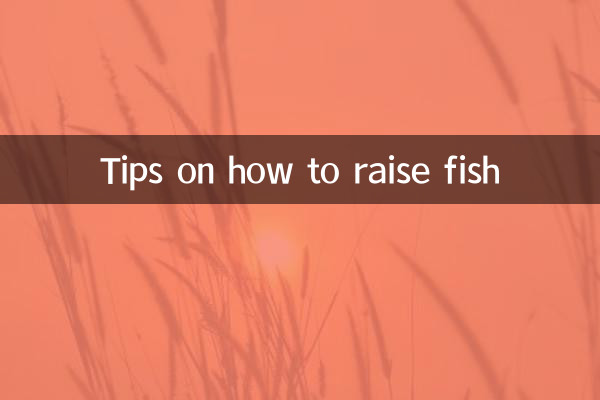Tips on how to keep fish: a comprehensive guide from novice to expert
Fish farming is an interesting and challenging hobby. Whether it is ornamental fish or edible fish, you need to master certain skills to make the fish grow healthily. This article will combine the hot topics and hot content on the Internet in the past 10 days to provide you with a structured guide to fish farming to help you get started easily and improve your fish farming skills.
1. Preparations before raising fish

Before you start raising fish, you need to make the following preparations:
| Project | Description |
|---|---|
| Fish tank selection | Choose the appropriate fish tank size based on the type and number of fish. It is generally recommended that novices start with a small fish tank. |
| Water quality testing | Ensure the water quality is suitable for fish survival, including pH value, ammonia nitrogen content, etc. |
| Filtration system | Choose the right filtration system to keep your water clean. |
| temperature control | Adjust the water temperature according to the type of fish, tropical fish need heating rods. |
2. Choose the right fish
The difficulty and needs of raising different fish vary. The following are some of the most popular ornamental fish and their characteristics:
| fish | Features | Difficulty of raising |
|---|---|---|
| Guppy | Colorful, easy to propagate, suitable for novices. | low |
| betta fish | It is highly solitary and does not require a filtration system, but it needs to be kept alone. | in |
| goldfish | It is cold tolerant but requires a large space and a good filtration system. | in |
| Colorful Angelfish | It has high requirements on water quality and is suitable for experienced breeders. | high |
3. Daily feeding and management
The daily management of fish farming is the key to ensuring the health of the fish. The following are some points to pay attention to:
| matters | Frequency | Things to note |
|---|---|---|
| feeding | 1-2 times a day | Avoid overfeeding as residual bait will pollute the water quality. |
| Change water | 1 time a week | Change 1/3 of the water each time to avoid drastic changes in water temperature. |
| Clean fish tank | 1 time per month | Clean up algae and sediment to keep water quality stable. |
| Check equipment | 1 time a week | Make sure the filtration system and heating rod are working properly. |
4. Common problems and solutions
It is inevitable to encounter some problems during the fish farming process. The following are common problems and solutions that have been hotly discussed by netizens recently:
| question | Reason | solution |
|---|---|---|
| Fish die frequently | Water quality issues or overfeeding | Check water quality and reduce feeding amount. |
| Algae growing in fish tank | Too much light or too much nutrition | Reduce lighting time and clean regularly. |
| fish fight | Territory battles or species conflicts | Keep them separately or add shelter. |
| Fish not eating | Unwell environment or illness | Check water quality and temperature and apply medication if necessary. |
5. Advanced skills: building an ecological fish tank
If you have mastered basic fish farming skills, you can try to build an ecological fish tank, where aquatic plants, fish and microorganisms form a balanced ecosystem. The following are the recently popular aquatic plants and matching suggestions:
| Types of aquatic plants | Features | Suitable for fish |
|---|---|---|
| moss waterweed | Slow growing and easy to maintain | small tropical fish |
| water banyan | Strong shade tolerance, suitable for novices | Colorful Angelfish |
| court grass | Grows rapidly and requires regular pruning | Guppy |
Through the above skills, you can gradually grow from a fish farming novice to an expert and enjoy the fun and sense of accomplishment brought by fish farming. Remember, the key to keeping fish is patience and care. Only with consistent care can the fish grow healthily.
I hope this article is helpful to you and I wish you happy fish farming!

check the details

check the details